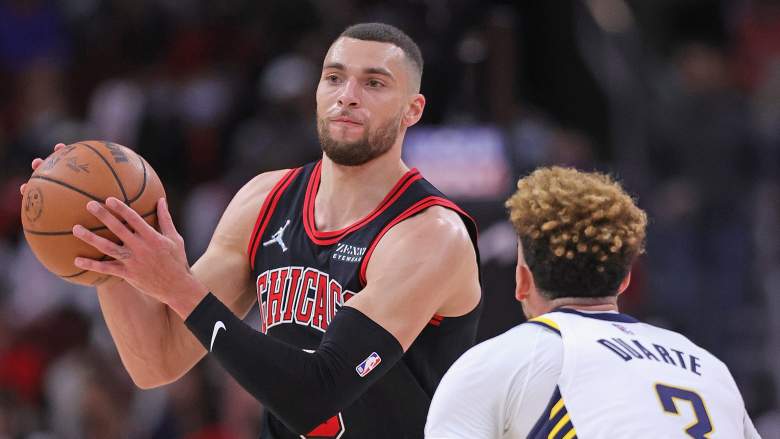
Getty Zach LaVine looks to make a play against Indiana Pacers rookie Chris Duarte,
During the 2020-2021 NBA season, Chicago Bulls guard Zach LaVine took a major leap in production, which led to his first All-Star selection.
The raw numbers weren’t necessarily far off his 2019-2020 campaign. His scoring averaged increased by just 1.9 points, he made 0.3 three-pointers more on average and he even took a small dip in free throws made per game by 0.1 makes.
What changed was his percentages that helped him achieve his line of 27.4 points per game. He hit 50.7% of all his shots, including 41.9% from long range, and 84.9% from the free throw line – All career-highs. This cocktail of numbers resulted in a true-shooting percentage of 63.4%, a tremendously high percentage for any perimeter player.
Sustainable Production?
The 2020-2021 season, of course, was when teams mostly played in empty arenas. As such, questions in fan circles arose about LaVine’s ability to sustain those numbers when fans returned.
After the Bulls traded for Nikola Vucevic, LaVine also saw a production decline, which further raised eyebrows. During the final 15 games of the season, he shot 46.9% from the field, 37.2% from long range and converted on 79.2% of his free throws.
Skepticism had been sewed.
Now, 30 games into the 2021-2022 season, LaVine has shushed his doubters. Once again, he’s hitting over 50% from the field (50.2), over 40% from range (41.6) and 80% from the line (84.1). He’s once more over 60% in true-shooting at 61.8% and has thus remained one of the most efficient perimeter scorers in the league.
61.8% is good enough to rank LaVine 25th in the league in that category. But that doesn’t do him justice, as a large group of players ahead of him are opportunistic big men who primarily score when being set up. Of players with similar offensive burdens as LaVine, only elite company of Nikola Jokic, Karl-Anthony Towns, Kevin Durant and LeBron James rank ahead of him.
However, the story doesn’t quite finish there.
LaVine hasn’t just remained efficient as a scorer, he’s improved his efficiency as a ball handler and passer, lowering the volume of bad passes considerably, while generally cutting down on turnovers.
Last season LaVine sported an acceptable turnover percentage of 13.4% on the season, which this year has been lowered to 11.4, a rock-solid number for any high-usage guard. This goes hand-in-hand with the fact that LaVine has become a much smarter passer. In 58 games last year, he had 113 turnovers categorized as “Bad Passes”. In 30 games this year, more than half the number of games he played last season, he’s been attributed with only 32 bad passes.
The Effect of Reinforcements
This is where observant readers will note that LaVine now plays alongside DeMar DeRozan and Lonzo Ball, who share ball handling duties with him, thus lowering the amount of time he spends on the ball.
This is true, and a very good point, dear reader. One of the luxuries of now playing with better players is the offering of a spread-out responsibility platter.
But for LaVine to benefit from having better players around him needn’t detract from his improvements. After all, a minor army of NBA stars have an additional star alongside them, making it a fair game all things considered.
Plus, it’s reasonable to make the argument that LaVine is doing exactly what he’s supposed to be doing. Playing to his strengths and avoiding areas where he could get into trouble.
Finally, there’s another layer yet to be fully considered by most who discuss LaVine: He might not be a finished product.
LaVine is a notoriously hard worker and has proven himself to be one of the most talented scorers in the NBA, further displayed by his 29.4-point average over his last seven games. He’s made strides as a defender in recent years, sharpened his jump-shot, added strength to handle contact better and has also developed a reputation as a culture setter.
Those are all indictive signs of a player maximizing his potential. At just 26, LaVine is far from a finished product, which should be baked in when evaluating his game moving forward for the next year or two.
